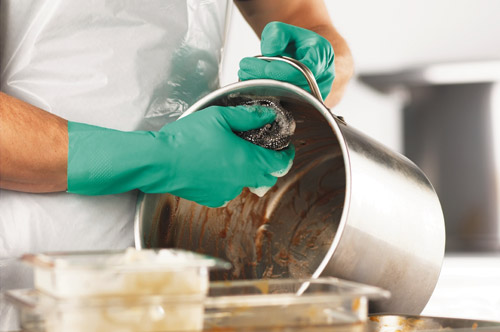What Foodservice Professionals Need to Know about the FDA Milk Testing Changes
In late-April and early-May 2025, headlines across the country and several social media posts stirred concern after reports surfaced that the U.S. Food and Drug Administration (FDA) had temporarily suspended part of its milk testing program. For foodservice operators, this raises an important question: does this change compromise the safety of milk—and by extension, dairy products served in commercial kitchens, cafeterias, and restaurants?
To clarify, the FDA did not stop testing milk for safety. The agency temporarily paused its milk proficiency testing program, which is designed to evaluate and certify the laboratories that conduct routine safety testing on milk. While the pause raised public alarm, the FDA emphasized it continues to test milk for contaminants like antibiotics, pathogens, and chemical residues. Milk sold across the country still undergoes rigorous testing through state-level and industry systems. As such, milk continues to be inspected and tested by regulatory authorities, just as it has been for the last century.
…from a safety standpoint, milk remains one of the most closely monitored food products in the United States.
From a safety standpoint, milk remains one of the most closely monitored food products in the United States. While I was in grad school, I had a professor who noted that the milk we pour in a foodservice or in our homes has been tested upwards of 15 different times before we consume it. As such, I think it is safe to say that foodservice operators can still rely on their dairy suppliers and regulatory bodies to maintain strict safety standards. However, public perception is just as important as the truth.
Consumer trust is a major pillar of food safety, and news headlines, even when misinterpreted, can erode that trust. For operators in schools, hospitals, and other institutions serving vulnerable populations, even a temporary perception of risk can lead to questions, concern, or changes in purchasing behavior.
Foodservice managers may find themselves fielding questions from staff or customers who have heard about the testing pause. It’s important to be proactive by educating your team members and, if appropriate, providing signage or statements that clarify the milk supply remains safe.
Now is also a good time to check in with your dairy vendors. Ask for updated safety protocols or third-party certifications. Transparency from suppliers helps reinforce your own credibility with customers and regulatory bodies.
While the FDA’s testing changes are not a direct threat, they’re a reminder that internal milk and dairy handling protocols should follow the food code and your established SOPs. Ensure cold chain practices, date labeling, and storage procedures are up to standard.
This one instance helps to illustrate just how easily regulatory changes, even temporary ones, can impact perception. Foodservice operations should include regulatory communication risks in their crisis planning. A prepared response helps maintain calm, trust, and consistency.
Although the FDA’s milk proficiency testing pause isn’t cause for alarm, it serves as a valuable case study in food safety communication and preparedness. For foodservice operations: stay informed, stay transparent, and be ready to reinforce confidence, not just in your dairy products and food, but in your entire safety culture. Risk Nothing.
READ MORE POSTS
Foodborne Illness Myths & Facts
“It must have been something I ate.” That’s the typical statement when a person develops some relatively minor symptoms from food. Maybe not severe enough to go to the doctor so you choose to tough it out without medical care. Sudden onset of flu-like symptoms such as onset of stomach cramps, diarrhea, vomiting and fever could possibly mean you are the victim of a foodborne illness. The illness is sometimes referred to as “food poisoning”, but it’s often misdiagnosed.
Don’t Compromise: Clean and Sanitize
The subject is cleaning and sanitizing. Chefs, food service directors, managers and staff try to practice safe food-handling at every turn in the kitchen. Don’t let that effort go down the drain by slacking off on the many aspects of sanitation. That includes dish and ware-washing techniques (pots, pans, equipment), and cleaning all the areas that give us that “neat as a pin” appearance in your customers eyes. Customers seldom fail to bring that soiled silverware or glass with lipstick on it to the attention of the manager or wait staff. Improperly cleaning and sanitizing of food contact equipment does allow transmission of pathogenic microorganisms to food and ultimately our customer.
The Route to Safer Fresh Fruits and Vegetables
Although fruits and vegetables are one of the healthiest foods sources in our diet, we continue to have foodborne disease outbreaks of significance from produce, sometimes affecting large groups of people in multiple states because of their wide distribution. The CDC estimates that fresh produce now causes a huge number of foodborne illness outbreaks in the United States. Produce needs our continued food safety efforts at the restaurant level as well as at the stages in agricultural production. Occasionally, fresh fruits and vegetables can become contaminated with harmful bacteria or viruses, such as Salmonella, E. coli 0157:H7, Norovirus, and Hepatitis A. This contamination can occur at any point from the field to our table. If eaten, contaminated fruits and vegetables can cause foodborne illness.
Be Cool, Chill Out, Refrigerate Promptly!
The Cold Chain -- Keeping perishable foods at proper cold holding temperatures (between 28°F and 41°F maximum or 0°F for frozen food) from your food producers / manufacturers to your customers has to be one of our strongest links to safe food and high quality. Sometimes that is referred to in the food industry as “maintaining the COLD CHAIN”. Any slip ups in the cold chain, and we have a weak link. Most all of our state food regulations require 41°F as a cold maximum, but colder is a “best practice” policy to maintain.










